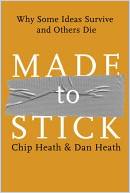Mega-bestsellers Chip and Dan Heath break down the components of ideas that stick, and offer suggestions for creating them.

Retention
In this New York Times bestseller, Chip Heath – a professor at Stanford University’s Graduate School of Business – and Dan Heath – senior fellow at Duke University’s Center for the Advancement of Social Entrepreneurship (CASE) – offer an engaging guide to devising ideas with maximum “stickiness.”
The Heath brothers take as their starting point Tipping Point author Malcolm Gladwell’s use of “stickiness” to describe innovations that are likely to find an audience. They embellish and expand his concept using many of his familiar methods – anecdotes, historical examples, non-linear conclusion-drawing and, in some cases, padding otherwise insubstantial ideas.
If you want to spread your ideas to other people, you should work within the confines of the rules that have allowed other ideas to succeed over time. You want to invent new ideas, not new rules.Chip Heath and Dan Heath
Like Gladwell, the Heaths have a knack for the memorable acronym. They demonstrate how communication that is simple, unexpected, concrete, credible, emotional and story-based (acronym: SUCCESs) makes ideas easy to understand, act on and remember. The Heaths, accordingly, provide mostly practical guidance that is easy to understand, specific, engaging and motivating – in other words, sticky.
SUCCESs
Comprehensible and memorable sticky ideas influence people’s thoughts and behaviors. The Heaths insist you can craft a sticky delivery for ideas that matter.
Sticky idea creation has an arch-nemesis: the Curse of Knowledge. People in charge of designing a sticky idea almost always know too much already.
There are, in fact, only two ways to beat the Curse of Knowledge. The first is not to learn anything. The second is to take your ideas and transform them.Chip Heath and Dan Heath
Academics and for-hire experts are the most likely to fall prey to this curse. Being subject experts, they’ve forgotten how little other people know and thus they default to associations that are lost on folks who don’t share their education, context or experience.
A Proverb
Keeping an idea simple doesn’t mean dumbing it down. Simplicity means stripping out details and subtleties until you reveal the idea’s essence. Present an idea succinctly, with elegance.
It is possible to create complexity through the artful use of simplicity. If simple ideas are staged and layered correctly, they can very quickly become complex. Chip Heath and Dan Heath
Your sticky idea is, ideally, a proverb: simple, brief and profound.
Guessing Machine
The human mind, the Heaths note – as do many authors – pays attention to novelty and change. To get its attention, break a pattern by doing something different and unexpected.
If you want your ideas to be stickier, you’ve got to break someone’s guessing machine and then fix it.Chip Heath and Dan Heath
Surprise occurs when your internal guessing machine turns out to be wrong. When you surprise people, they want to know why their expectations weren’t correct. Help people make sense of their surprise, and your idea will stick.
Concrete Language
Familiar, concrete, specific language helps people grasp an idea and retain it. If you use vague, general terms, people will interpret them subjectively or find them too heady. For instance, proverbs and fables use tangible descriptions set in recognizable contexts.
Language is often abstract, but life is not abstract…Abstraction is the luxury of the expert. Chip Heath and Dan Heath
Concrete language derives from the senses – what you can see, touch, smell, hear and taste. People retrieve sense-related information more easily than they retrieve abstract concepts, so the more sensory cues your sticky idea invokes, the more memorable it will become.
Using concrete terms puts everyone – no matter their level of expertise – on the same footing, thus facilitating communication and collaboration. To get sticky, keep your vocabulary in the realm of the senses.
Authority
If someone your audience trusts, likes, admires or finds authentic endorses your idea, his or her credibility enhances your concept’s stickiness.
Statistics also can create credibility, not because people remember the numbers – they don’t – but because numbers create a visceral impression of validity, thus bypassing rational processes.
Statistics will, and should, almost always be used to illustrate a relationship. It’s more important for people to remember the relationship than the number. Chip Heath and Dan Heath
Use data to develop and test an idea. Never massage data or spin it to support a preconceived notion. Data offers your audience a way to verify a sticky idea’s claims for themselves.
Emotional Content
Emotional connection moves people to action. You want to transfer an emotional charge from something people already care about to your sticky idea.
The most basic way to make people care is to form an association between something they don’t yet care about and something they do care about. Chip Heath and Dan Heath
People respond to emotional appeals to their higher ideals or group interests. The Heaths explain that people make choices by calculating likely outcomes and picking the outcome that’s most valuable to them or by asking themselves how those who are “like them” – or like the people they want to be – behave in similar circumstances. When you invoke the identity-based mode, people might take action due to affinity instead of self-interest.
Stories
Telling a story can drive people to act. Stories provide concrete contexts for ideas and actions. People enter into stories as their brains create physical, visual, spatial and auditory simulations.
Stories are like flight simulators for the brain…Inside, we’re getting ready to act.Chip Heath and Dan Heath
Exploit three plotlines: the Challenge plot – an underdog overcomes tremendous odds, exemplifying courage and perseverance; the Connection plot – people bridge social divides for the common good, evoking compassion and service; and the Creativity plot – a story of breakthrough solutions and innovations that inspire people to new approaches.
Internal Communications
Sticky strategic communication provides a common language for discussing problems and developing solutions.
The moral is implicit in the story, but the story is not implicit in the moral. And the story…is more likely to guide behavior. Chip Heath and Dan Heath
Make your strategic messaging concrete, story-driven and unexpected – that is, counterintuitive.
Stickier
Urban legends, celebrity scandals, product rumors and political lies are sticky. Debunking and fact-checking seldom unstick them.
We should fight sticky with stickier, meet Scotch tape with duct tape. Chip Heath and Dan Heath
The authors suggest pivoting the discussion from the original idea to an even stickier, but healthier, more constructive one. Easier said than done, perhaps, but still proactive.
Review
The Heaths are seasoned, successful hands at the intellectual advice game and understand how to stretch a magazine article into a book, with only a few padded sequences. They have a knack for understated wit and for letting their amusing examples of people’s idiocy or gullibility stand on their own without excess explanation. Whether they can teach you to make your ideas sticky is another question. The Heaths offer a blueprint that reads well and provokes thought, but doesn’t quite provide the cognitive leaps that stickiness requires. It does, however, prove a worthy starting place.
Chip Heath and Dan Heath co-authored Switch, The Myth of the Garage, The Power of Moments and Decisive. Dan Heath also wrote Upstream; and Chip Heath co-authored Making Numbers Count with Karla Starr.




